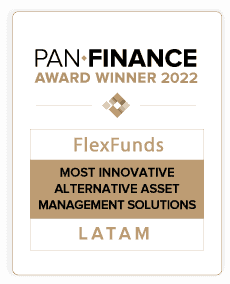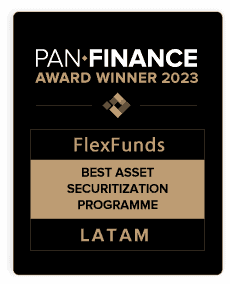- This article outlines the main tools and needs to consider in asset management, according to the II Annual Report of the Asset Securitization Sector 2024-2025, developed by FlexFunds in collaboration with Funds Society.
- The information is primarily aimed at asset and fund managers who want to understand the advantages and disadvantages of centralized account management, the improvement of strategy distribution, and other key aspects of asset management.
- At FlexFunds, we offer asset securitization solutions to issue exchange-traded products (ETPs) that can enhance investment strategy distribution. For more information, please feel free to contact our team of experts.
To be a key player in asset management, not only must you possess extensive knowledge and experience, but you also need to leverage specific tools and properly identify client needs.
According to the II Annual Report of the Asset Securitization Sector 2024-2025, prepared by FlexFunds in collaboration with Funds Society, the most significant tools and needs are related to centralized account management, automated and/or outsourced NAV calculation and reporting, improving the distribution of investment strategy, and streamlining the investor onboarding process.
Download our infographic
Centralized account management
Centralized account management in asset management involves administering all client accounts from a single platform or centralized system.
Centralized management is crucial for operational efficiency and control, allowing managers to have a holistic view and handle large volumes of information effectively.
Advantages
- Efficiency and economies of scale: Reduces duplication of efforts and manual errors.
- Control: Greater visibility and control over all accounts.
- Simplification: Simplifies the tracking and asset management process.
Disadvantages
- Initial cost: Implementing and maintaining a centralized system can be expensive.
- Security: Cybersecurity risks arise from having all data centralized.
- Technology dependency: A robust technological infrastructure is required.
Automated and/or outsourced NAV calculation and reporting
This process is crucial for improving both accuracy and efficiency, as it frees managers to focus on strategic decision-making.
In this sense, the net asset value (NAV) is automatically calculated and reported through automated systems or outsourced to a specialized provider.
Advantages
- Accuracy: Reduces human error in calculations.
- Speed: Faster and more frequent calculations and reports.
- Focus on core activities: Allows managers to concentrate on strategic decisions rather than operational tasks.
Disadvantages
- Outsourcing costs: Paying an external provider can be expensive.
- Provider dependency: There’s a risk associated with the quality and reliability of the provider.
- Adaptability: Automated systems may require continuous updates and adaptations.
Enhancing investment strategy distribution
This factor is vital for asset management as it helps attract and retain investors, ensuring that clients understand and trust the investment strategy.
It involves optimizing how the investment strategy is communicated and distributed to clients and potential investors.
Advantages
- Transparency: Improves transparency and investor confidence.
- Investor attraction: A well-communicated strategy can attract more investors.
- Client retention: Increases satisfaction and loyalty among existing clients.
Disadvantages
- Marketing effort: Requires a well-developed and consistent marketing strategy.
- Resources: Investment in personnel and tools for communication and distribution may be necessary.
- Competition: Poorly executed strategies may be copied by competitors.
Streamlining investor onboarding
Streamlining investor onboarding refers to optimizing and simplifying the process through which new investors sign up and start investing.
Companies should make it easier for new investors to onboard using advanced technologies and automated processes.
Advantages
- Client experience: Enhances the client experience by making the process smoother and more enjoyable.
- Lower barriers: Reduces obstacles for new investors to start investing.
- Scalability: Enables the management of a larger number of new investors without significantly increasing required resources.
Disadvantages
- Initial cost: Developing automated systems and processes may involve a high price.
- Regulation: Complying with regulations and standards can be complex and costly.
- Security: This is a critical aspect, and to prevent potential fraud, it’s essential to ensure systems and their integrations with third parties are adequately protected against cyberattacks.
The key elements in asset management
The results of the II Annual Report of the Asset Securitization Sector 2024-2025 showed that all these factors are relevant for asset management.
However, when each was rated on a scale from 1 (least important) to 5 (most important), investor onboarding and NAV calculation and reporting stood out, with 72% and 71% of importance, respectively. These were followed by improving investment strategy distribution (65%) and centralized account management (61%).
“Facilitating investor onboarding, along with NAV calculation and reporting, could be considered the most important for business growth and scalability. Without a smooth and continuous influx of new investors or an efficient and agile reporting system, it’s difficult to maintain and expand the client base, which is essential for long-term success,” explained the experts in charge of the study.
Additionally, the strength of the correlation between the four factors was analyzed through a correlation matrix, leading to the conclusion that clients value an integrated and efficient asset management experience, where automation, centralized account management, and streamlined onboarding play key roles and are interrelated.
Thanks to the information gathered by FlexFunds and Funds Society, based on the opinions of experts from 100 companies across 18 countries, the four main tactics that portfolio managers should consider to maintain and grow in the industry were identified.
To learn more, feel free to download the II Annual Report of the Asset Securitization Sector 2024 – 2025 easily and free of charge.







